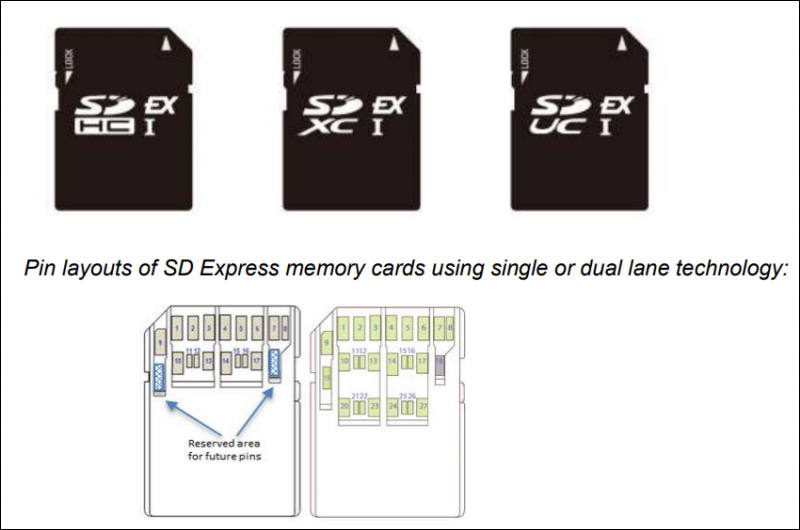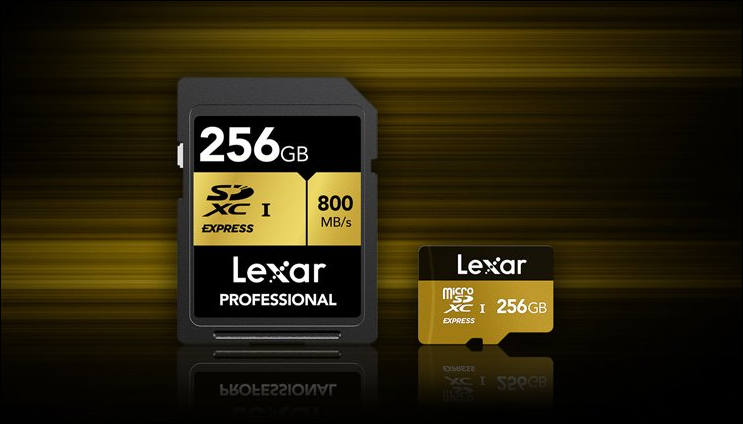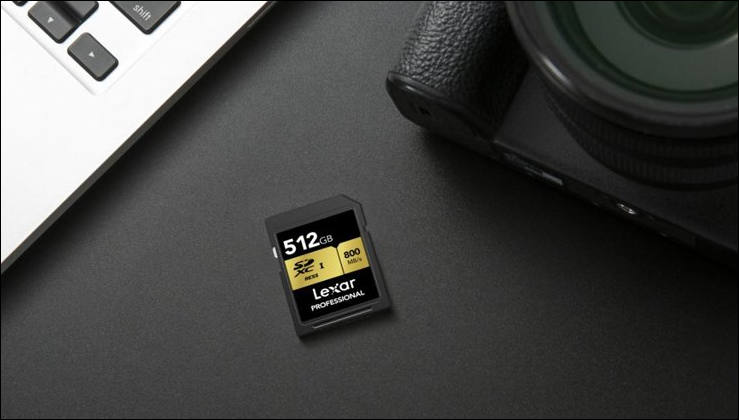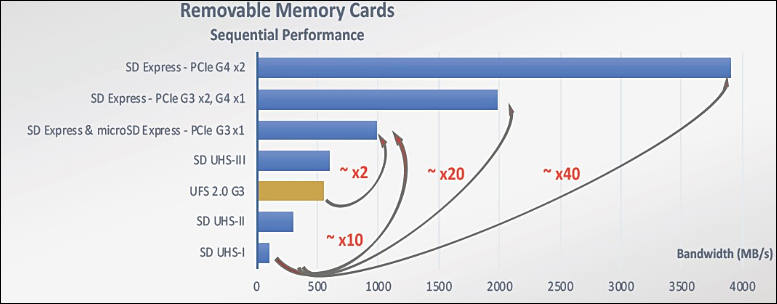
-

The SD Association announced today the SD 8.0 Specification for SD Express memory cards receives even faster transfer speeds by using the popular PCI Express® (PCIe®) 4.0 specification delivering a maximum of nearly 4 gigabytes per second (GB/s) data transfer rate. These full sized cards continue to use the NVMe Express™ (NVMe™) upper layer protocol enabling advanced memory access mechanism. As always SD Express memory cards using SD 8.0 specification maintain backward compatibility.
“SD Express’ use of even faster PCIe and NVMe architectures to deliver faster transfer speeds creates more opportunities for devices to use SD memory cards,” said Mats Larsson, Senior Market Analyst at Futuresource. “This combination of trusted and wellknown technologies makes it easier for future product designs to leverage the benefits of removable storage in new ways.”
SD Express gigabyte speeds bring new storage opportunities for devices with demanding performance levels, across a variety of industries. The cards can move large amounts of data generated by data-intense wireless or wired communication, superslow motion video, RAW continuous burst mode and 8K video capture and playback, 360 degree cameras/videos, speed hungry applications running on cards and mobile computing devices, ever evolving gaming systems, multi-channel IoT devices and automotive to name a few. SD Express will be offered on SDHC, SDXC and SDUC memory cards.
“By dramatically increasing the speeds for SD Express we’re giving device manufacturers and system developers more storage choices,” said Hiroyuki Sakamoto, SDA president. “SD 8.0 may open even more opportunities for extra high performance solutions using removable memory cards.” “PCI-SIG® is pleased to see that SDA is continuing to adopt even faster PCIe technology configurations using PCIe 4.0 interface and dual lanes for one of the top leading removable memory cards – SD,” said Al Yanes, PCI-SIG president and chairman. “PCIe specification conformance tests are available today by major test vendors, offering a significant advantage for any new PCIe technology adopter.”
“NVMe is the industry-recognized performance SSD interface from the client to the datacenter, shipping in millions of units,” said Amber Huffman, NVM Express™ Inc. president. “Consumers will benefit by SD Association continuing the adoption of the NVMe base specification for their latest SD Express cards.”
SD Express uses the well-known PCIe 4.0 specification and the latest NVMe specification (up to version 1.4) defined by PCI-SIG and NVM Express, respectively. SD 8.0 specification provides two transfer speed options for SD Express memory card. The two transfer speeds are accomplished by supporting either PCIe 3.0 x2 or PCIe 4.0 x1 architectures with up to ~2GB/s and with PCIe 4.0 x2 technology with up to 4GB/s. SD Express cards offering PCIe 4.0 x1 architecture use the same form factor as defined for SD 7.0 specification cards with a second row of pins to deliver transfer speeds up to 2 GB/s. SD Express cards supporting dual PCIe lanes (PCIe 3.0 x2 or PCIe 4.0 x2 technologies) have three rows of pins.
The SDA makes adoption of SD Express easy allowing companies to use existing test equipment and saving in product development costs. The SD 8.0 specification continues giving system developers access to PCIe and NVMe technologies, such as Bus Mastering, Multi Queue (without locking mechanism) and Host Memory Buffer.
-
Adata announced plans to launch SD Express memory cards. These high-speed removable media will begin shipping in the second quarter of 2021.
These cards are described in the SD 7.0 standard adopted by the SD Association (SDA) in 2018. The main innovation in SD 7.0 is PCIe and NVMe support. It offers dramatic increases in read and write speeds over previous generation SD cards. Maximum SD speed of 312 MB / s is limited by the capabilities of the UHS-II interface. SD Express cards have retained the SD form factor, but are three times faster than their predecessors in maximum speed.
Memory cards, which Adata plans to release, equipped with PCIe Gen3 x1 interface, will demonstrate read and write speeds of 825MB/s and 410 MB/s.
Now none of the cameras has or even plan to support SD Express memory cards.
-
Lexar has announced that it is actively developing on the thus far unused SD Express specification to create SD memory cards that use PCI Express (PCIe 4.0) and will more than triple the speeds of current UHS-II cards, but it’s not clear who these cards will work for.
Lexar SD Express and microSD Express memory cards will feature write speeds of up to 410MB/s and read speeds of up to 824MB/s, respectfully.
Nice.
-
More details on Lexar cards


Lexar SD Express products use the PCI Express (PCIe) 4.0 specification and the NVMe Express (NVMe) protocol. The declared data transfer speed in read mode reaches 985 MB / s.
SD Express cards will be offered in versions up to 512GB. In addition, Lexar will release microSD Express products: their capacity will be up to 256 GB.
The new products will be based on the Silicon Motion SM 2708 controller. It is claimed that the data recording speed in real conditions will be up to 410 MB / s.

 sa17553.jpg743 x 424 - 36K
sa17553.jpg743 x 424 - 36K
 sa17554.jpg739 x 420 - 32K
sa17554.jpg739 x 420 - 32K
Howdy, Stranger!
It looks like you're new here. If you want to get involved, click one of these buttons!
Categories
- Topics List23,993
- Blog5,725
- General and News1,355
- Hacks and Patches1,153
- ↳ Top Settings33
- ↳ Beginners256
- ↳ Archives402
- ↳ Hacks News and Development56
- Cameras2,367
- ↳ Panasonic995
- ↳ Canon118
- ↳ Sony156
- ↳ Nikon96
- ↳ Pentax and Samsung70
- ↳ Olympus and Fujifilm101
- ↳ Compacts and Camcorders300
- ↳ Smartphones for video97
- ↳ Pro Video Cameras191
- ↳ BlackMagic and other raw cameras116
- Skill1,960
- ↳ Business and distribution66
- ↳ Preparation, scripts and legal38
- ↳ Art149
- ↳ Import, Convert, Exporting291
- ↳ Editors191
- ↳ Effects and stunts115
- ↳ Color grading197
- ↳ Sound and Music280
- ↳ Lighting96
- ↳ Software and storage tips266
- Gear5,420
- ↳ Filters, Adapters, Matte boxes344
- ↳ Lenses1,582
- ↳ Follow focus and gears93
- ↳ Sound499
- ↳ Lighting gear314
- ↳ Camera movement230
- ↳ Gimbals and copters302
- ↳ Rigs and related stuff273
- ↳ Power solutions83
- ↳ Monitors and viewfinders340
- ↳ Tripods and fluid heads139
- ↳ Storage286
- ↳ Computers and studio gear560
- ↳ VR and 3D248
- Showcase1,859
- Marketplace2,834
- Offtopic1,320






